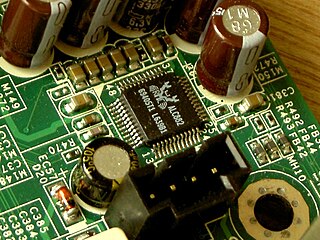
Ogg is a free, open container format maintained by the Xiph.Org Foundation. The creators of the Ogg format state that it is unrestricted by software patents and is designed to provide for efficient streaming and manipulation of high-quality digital multimedia. Its name is derived from "ogging", jargon from the computer game Netrek.
Speex is an audio compression format specifically tuned for the reproduction of human speech and also a free software speech codec that may be used on VoIP applications and podcasts. It is based on the CELP speech coding algorithm. Speex claims to be free of any patent restrictions and is licensed under the revised (3-clause) BSD license. It may be used with the Ogg container format or directly transmitted over UDP/RTP. It may also be used with the FLV container format.
DivX is a brand of video codec products developed by DivX, LLC. The DivX codec gained fame for its ability to compress lengthy video segments into small sizes while maintaining relatively high visual quality.
Theora is a free lossy video compression format. It is developed by the Xiph.Org Foundation and distributed without licensing fees alongside their other free and open media projects, including the Vorbis audio format and the Ogg container.
Xiph.Org Foundation is a non-profit organization that produces free multimedia formats and software tools. It focuses on the Ogg family of formats, and the most successful one has been Vorbis, an open and freely licensed audio format and codec designed to compete with the patented WMA, MP3 and AAC. As of 2013, the current development work is focusing on Daala, an open and patent-free video format and codec designed to compete with VP9 and the patented High Efficiency Video Coding.
The enhanced versatile disc (EVD) is an optical-medium-based digital audio/video format, developed by Beijing E-World, as a rival to the DVD to avoid the high royalty costs associated with the DVD format. Its development was supported by the Chinese government. While it was intended to replace the DVD standard in China by 2008, the format had failed to gain traction and ultimately faded into obsolescence.
Nullsoft Streaming Video (NSV) was a media container designed for streaming video content over the Internet. NSV was developed by Nullsoft, the makers of Winamp.
OpenMAX, often shortened as "OMX", is a non-proprietary and royalty-free cross-platform set of C-language programming interfaces. It provides abstractions for routines that are especially useful for processing of audio, video, and still images. It is intended for low power and embedded system devices that need to efficiently process large amounts of multimedia data in predictable ways, such as video codecs, graphics libraries, and other functions for video, image, audio, voice and speech.
The following comparison of video players compares general and technical information for notable software media player programs.
ffdshow is an open source unmaintained codec mainly used for decoding of video in the MPEG-4 ASP and H.264/MPEG-4 AVC video formats, but it supports numerous other video and audio formats as well. It is free software released under GNU General Public License 2.0, runs on Windows, and is implemented as a Video for Windows (VFW) codec and a DirectShow filter.

Intel High Definition Audio is a specification for the audio sub-system of personal computers. It was released by Intel in 2004 as successor to their AC'97 PC audio standard.
This table compares features of container formats. To see which multimedia players support which container format, look at comparison of media players.
Exact Audio Copy (EAC) is a CD ripping program for Microsoft Windows. It has also been tested to work under newer versions of Wine on Linux. The program was created by Andre Wiethoff in 1998, while he was a student at the University of Dortmund in Germany. Wiethoff stated that he became "fed up with other audio grabbers" that only do jitter correction while scratched CDs often produce distortions, and decided to develop his own.
The following tables compare general and technical information for a variety of audio coding formats. For listening tests comparing the perceived audio quality of audio formats and codecs, see the article Codec listening test.
internet Speech Audio Codec (iSAC) is a wideband speech codec, developed by Global IP Solutions (GIPS). It is suitable for VoIP applications and streaming audio. The encoded blocks have to be encapsulated in a suitable protocol for transport, e.g. RTP.

VP8 is an open and royalty free video compression format owned by Google and created by On2 Technologies as a successor to VP7.

Blu-code is a professional Blu-ray authoring software, supporting H.264 and MPEG-2 encoding. Blu-code can support a large-scale distributed processing system deploying a number of PCs for real-time encoding or run on a single PC.
The HTML5 specification introduced the video element for the purpose of playing videos, partially replacing the object element. HTML5 video is intended by its creators to become the new standard way to show video on the web, instead of the previous de facto standard of using the proprietary Adobe Flash plugin, though early adoption was hampered by lack of agreement as to which video coding formats and audio coding formats should be supported in web browsers.

Opus is a lossy audio coding format developed by the Xiph.Org Foundation and standardized by the Internet Engineering Task Force, designed to efficiently code speech and general audio in a single format, while remaining low-latency enough for real-time interactive communication and low-complexity enough for low-end embedded processors. Opus replaces both Vorbis and Speex for new applications, and several blind listening tests have ranked it higher-quality than any other standard audio format at any given bitrate until transparency is reached, including MP3, AAC, and HE-AAC.
HTML5 Audio is a subject of the HTML5 specification, incorporating audio input, playback, and synthesis, as well as speech to text, in the browser.